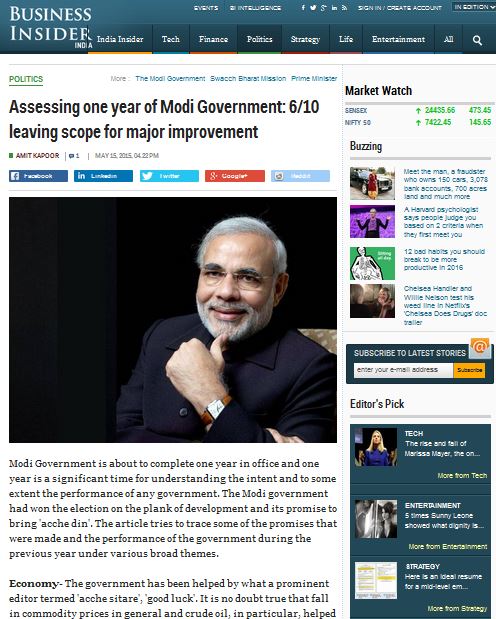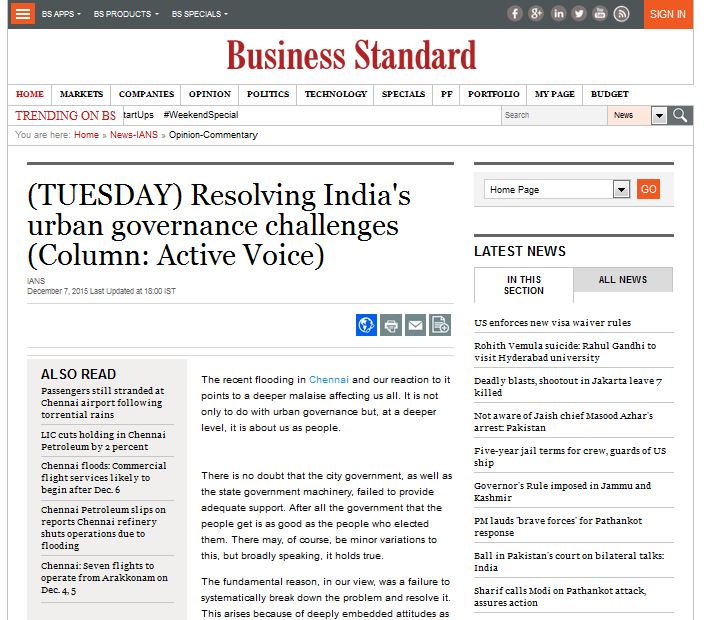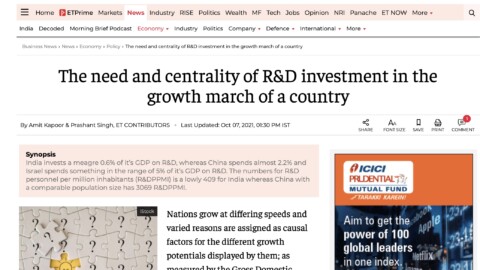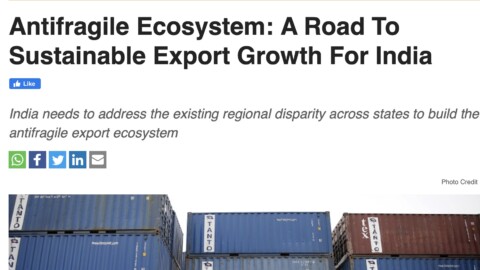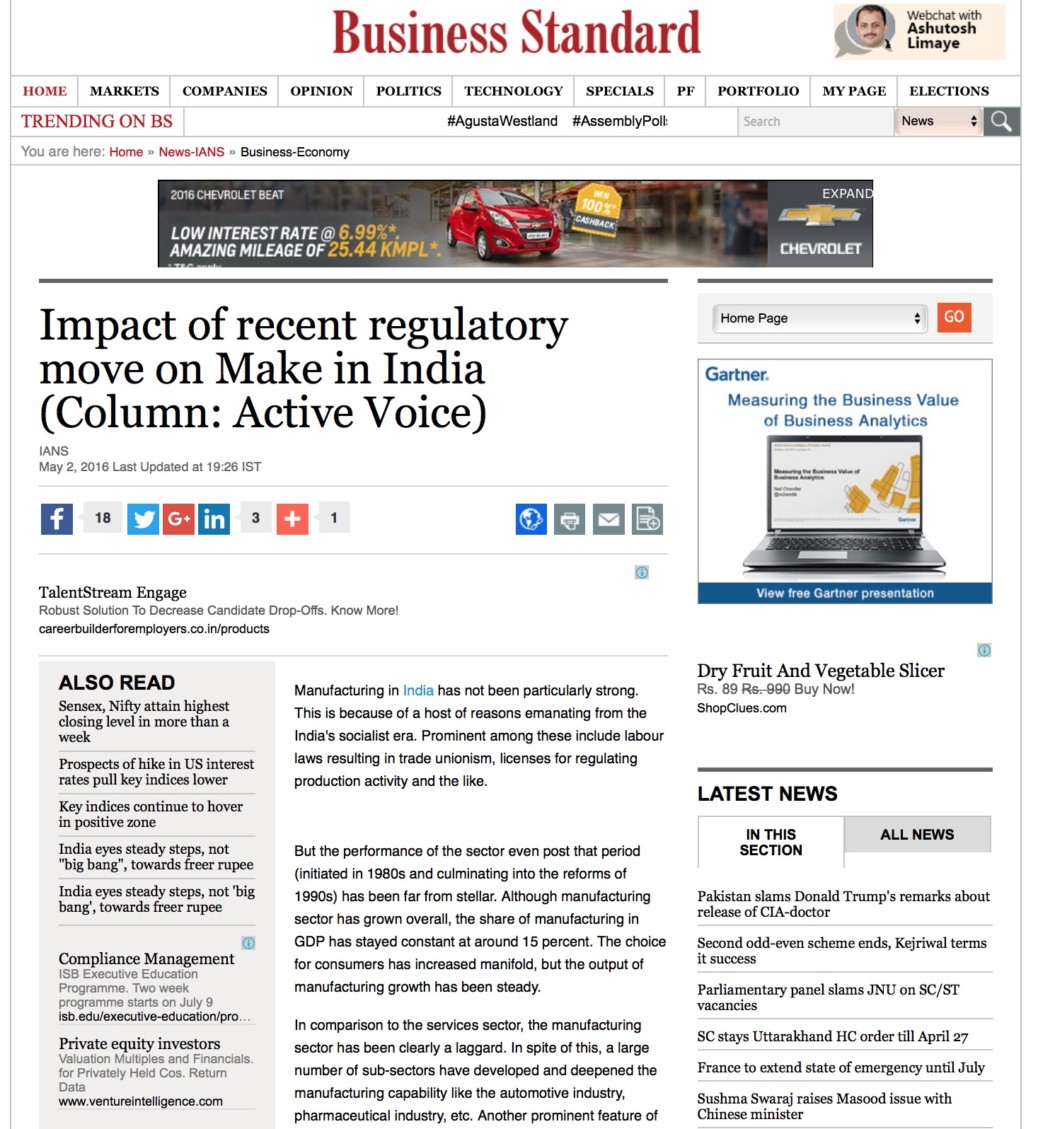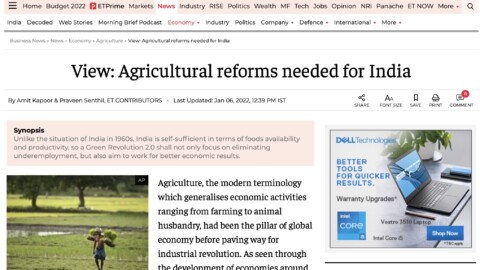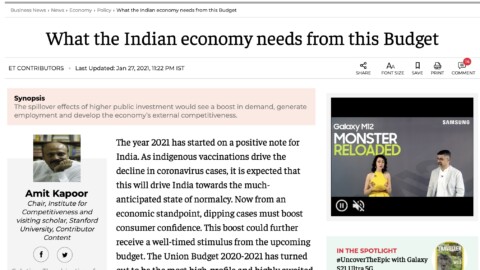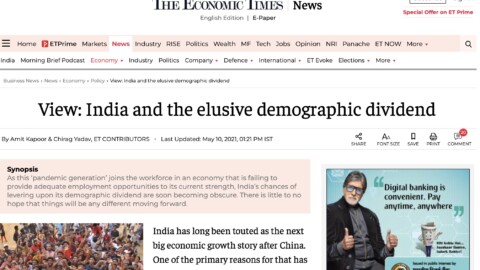Assessing one year of Modi Government: 6/10 leaving scope for major improvement
Modi Government is about to complete one year in office and one year is a significant time for understanding the intent and to some extent the performance of any government. The Modi government had won the election on the plank of development and its promise to bring ‘acche din’. The article tries to trace some of the promises that were made and the performance of the government during the previous year under various broad themes.
Economy- The government has been helped by what a prominent editor termed ‘acche sitare’, ‘good luck’. It is no doubt true that fall in commodity prices in general and crude oil, in particular, helped the government reign in the fiscal deficit and give it headway to make fiscal policies for the country. The fiscal deficit target for 2015-16 has been the pegged by the budget to 3.9%. While this is little above than recommendations of the Fourteenth Finance Commission ( which recommended it to be 3.6 percent of the GDP), the government has understandably batted for growth. The government still is slowly but surely moving towards the limit set by FRBM (Fiscal Responsibility and Budgetary Management) Act, 2003 that pegged the target at a maximum level of 3% of the GDP. The government has also tried to help the economy gain momentum by enabling legislation for reforms. These included trying to go in for a major reform in the indirect taxation regime as well as accepting the recommendations of Fourteenth Finance Commission in respect to revenue sharing with states. It was ostensibly done to ensure a spirit of ‘cooperative federalism’ between states and center, as well as greater financial devolution to states. The figure now stands at 42% of the total revenue collection up from the earlier 32%. Also, the year saw growth forecasts been revised for India by a number of International Bodies and agencies. The IMF revised its forecasts to 7.5 % In 2015 in its WEO April 2015 forecast. It was up from the 6.4 projected for 2015 in the WEO April 2014 forecast. Similarly, the Asian Development Bank in its Asian Development Outlook 2015, indicated a bettering economy with less than 5 percent core inflation. They also alluded to the new monetary policy framework according to which RBI, India’s central bank is to play the role of price stabilization primarily while being mindful of growth. With the policy framework in place, the central bank will be maintaining the inflation target of 4±2 % from FY 2016 onwards. Thus with an overall bettering situation a total score of 7.5 out of 10.
Foreign Engagement and Defence- Foreign engagement was by far the area where the most vigorous activity and keen intent were observed. The sphere saw initiatives undertaken by the PM himself to make India more noticeable as well as more integrated with the International sphere. It included among many things, trips to foreign countries both in the neighbourhood as well as to countries like Germany, France, Australia, US, Canada and most recently beginning May 14, 2015 his trip to China. The engagement also saw a large number of foreign dignitaries coming to India from across the world. The engagement also saw bilateral agreements as well as plans to invest in India’s development by countries and companies abroad, most notably by Japan, US and China. Also, steps to resolve contentious issues have been undertaken pertaining to the border areas with neighbours. It includes the recently passed Bangladesh Land Accord Bill that envisages transferring enclaves and demarcation of the boundary along the present porous borders. Also, in the broad sphere of defence the decision to acquire 36 Rafale fighter jets is a welcome step. More such acquisitions will have to be made since these 36 planes would add just two squadrons to thirty-five squadrons that IAF has. It is below an authorized strength of forty-two which will be down to twenty- five by 2022. It means we must speed up the process of defense acquisitions since there is urgent need to upgrade and modernize the armed forces and security apparatus in India. Overall a score of 8.5 out of 10 foreign engagement and 7.5 out of 10 on defence.
Agriculture- Here the government has not been able to do that well, and it is understandable because there has been erratic weather accentuated by some mismanagement by the government. The sector is critical as most people are dependent on it for employment. Added to the weather were the issues of land acquisition and urea availability to farmers. Land Acquisition Bill though being blocked by the opposition on the farmer rights plank is linked directly to the development of clusters and employment of youth for especially rural areas. The focus of the government seems to be the development of irrigation facilities under its Pradhanmantri Krishi Sinchai Yojana. A fund was proposed to be set up for marginalized farmers with a corpus of Rs. 25000 crores in NABARD. An overall score of 6.5 on 10.
Industrial policy and power- Industrial policy saw a continuity from the previous regime. The National Manufacturing Policy (NMP) was hailed by the ‘Make in India’ as the ‘most comprehensive and significant policy initiative of the government’. The ‘Make in India’ is an initiative that is critically dependent on other factors. These include availability of land, ease of doing business as well as removal of inverse duty structures that make imports of finished products cheaper than finished products. Apart from this labour policies that favour flexibility in hiring and firing are also seen to be the main bottlenecks. While the government has taken some steps to rectify, these bottlenecks outcomes are yet to be seen. Similarly, the FDI policy has seen incremental reforms with the opening up of insurance and defence sectors further to 49% from the earlier limit of 26%. Both these are positive steps for the economy. Greater structural changes could have been undertaken in these spheres especially with the mandate, but nonetheless significant work is been done. In the power sector, much has been achieved. It included the successful auction of the coal mines, which is slated to rope in a massive 15 lakh crore over the 30-year timeframe if all the mines are auctioned and are working at optimum output. Apart from this coal production was at an all-time high as well as the government seems on track to meet the power requirements of the country. Overall a score of 6.5 for industries and a score of 8 for power out of 10.
Education- The countries’ education system can broadly be classified under two broad areas- higher education and school education. There are several schemes that are operational under these. The government in the past one-year has come up with several new initiatives including the Beti-Bachao Beti Padhao Abhiyan, Swachh Vidyalaya and GIS Mapping of schools and has opened several new institutions. However, the fact remains that despite all government’s initiatives most people if given a choice, prefer private schooling since it gives their children a competitive edge later on in their careers. The governments of the past have failed in this and correcting this anomaly will take time. Also, in respect to higher education the government seems keen to have holistic development with several new AIIMS, IIM and IIT like institutions being opened in states that have a paucity of these. What remains to seen is how quality and not just quantity is pursued within these institutions while ensuring regional development. An overall score of 6.5 on 10.
Infrastructure- The primary focus of the government in this sphere is up-gradation of existing and quick development of new infrastructure. The first can be observed in the push for railway up-gradation and improvement in customer service. The second can be observed more in the highways sector with the minister setting himself a target of 30 km a day by 2017. In March this year 11 km of roads were being laid. The broad ambit of infrastructure covers the development of roads, highways, ports, airport, waterways, canals, and railways. It is too early to judge the government’s progress on the same however the fact that there is clearance for projects worth close to Rs. 6 lakh Crore across 10 key sectors. It shows intent on the part of government for infrastructure development. Overall a score of 7.5 on 10.
Social Schemes- The social schemes of the government have been particularly impressive. These include the Jan Dhan Yojana, Pradhan Mantri Jivan Jyoti Bima Yojana (PMJJBY) Pradhan Mantri Suraksha Bima Yojana (PMSBY) and Atal Pension Yojana and many other social missions like the Swacch Bharat Mission and the Clean Ganga Mission. For the Jan Dhan Yojana already around 12.5 crore accounts have been opened along with a capital infusion of Rs 10,500 crore into the system. The three recently launched social security schemes (namely the (PMJJBY), Pradhan Mantri Suraksha Bima Yojana ) and Atal Pension Yojana) have got nearly 6.5 crore subscriptions. It is because (PMJJBY) scheme offers Rs. 2 lakh cover for a mere 330 Rs. Per year (provided bank account holders are from age 18-50). Under the (PMSBY), renewable one-year accident cum disability cover of Rs. 2 lakh is provided for Rs.12 premium every year. The Atal Pension Yojana is aimed at those people who work in the unorganised sector and do not fall under the ambit of regular pension. The scheme offers pension under various brackets depending on the contribution made over a period. The scheme is for people in the age bracket 18-40 years. The social focus of the government is also evident from the fact the government has continued with previous schemes and linked them with technology for targeted interventions. The JAM (Jan Dhan Account, Aadhaar Cards and Mobiles) number Trinity as mentioned in the budget speech is an example of the same. The government seems to have a social focus for benefit to poor. An overall score of 8 on 10.
Urbanization and Urban development- The urbanization and urban development received an increased thrust under the 100 Smart City project. The thrust of the present government is not only on up gradation of brownfield cities but also development of new greenfield cities. Traditionally, India has been slow to urbanize, and at present 32 percent of people reside in urban areas. However, the quality of urban life has seen a precipitous decline in the past few decades. The government’s smart city initiative is a step aimed at understanding and absorbing the migration of people from rural to urban areas. However, the implementation of the project holds the key. Success in greenfield development is critically linked to land acquisition. Also, will the ‘smart cities’ improve liveability for the ever-burgeoning population remains to be seen? The project is ambitious in scope and the past year has seen some activity with the launch of the GIFT city in Gujarat and work on cities of DMIDC. An overall score of 6.5 on 10.
Health and Environment- Health along with education have been two areas where successive governments have faltered. The system in India needs a drastic overhaul and increased spending by the government. Also there is a severe shortage of trained personnel in the sector. Add to this the decrepit facilities in rural areas that forces one to look at ways and means to better delivery. The activity in the health ministry was seen to be rather subdued. However, the taxation on cigarettes ensures that a majority of population reconsiders decision to buy cigarettes. The quality of air and the general pollution levels in Indian cities pose serious health issues for all residents. Disease patterns are also changing and this calls for a comprehensive approach to healthcare access and delivery. Not much has been done in this regard. An overall score of 6 on 10.
Entrepreneurship and Employment- For the first time a separate ministry for entrepreneurship has seen the light of the day. This fact along with the fact that skilling are the main thrust areas of the ministry make it clear that the government is in sync with the present ground reality. A million people will enter the workforce every month over the next decade. So it becomes imperative that India produces jobs for its burgeoning workforce. That will not just come from formal and informal sector but will require a thrust for entrepreneurship. Similarly, thrust for skilling is imperative. Further, a draft policy on skill development and entrepreneurship has already been made and put out for public consultation. Though much remains to be seen in terms of its impact the direction and intent, in this case, seems to be spot on. An overall score of 7.5 on 10.
Overall, in assessing the performance, the government seems to have taken cognizance of the major challenges facing India in multiple spheres and taken requisite steps. It seems to be headed in the right direction. It augurs well for India in the medium to long term. Much will depend on the speed of legislation, decision-making and implementation over the next four years.
Published in Business Insider on May 18, 2015. To know more
